This article can assist if you’re having trouble accessing your AOL mail on your iPad. The two most likely cases are:
1. AOL has sent you an email about new safety features. Here is an example of the format:
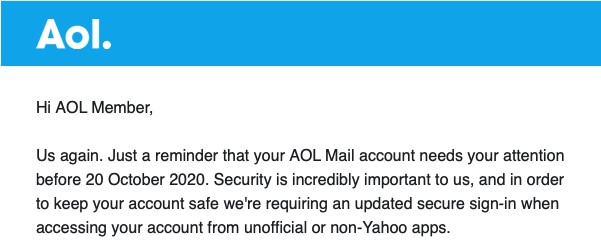
Or perhaps you suddenly cannot access your AOL mail on your iPad; you enter the password repeatedly, but it does not take, even though you are sure you know the correct one.
2. You seem to be experiencing additional problems while using AOL mail on an iPad.
Please note that this post contains all the information you need to know to set up an app-specific password and access AOL on an earlier iPad. Nothing is missing. You can fix your AOL Email not working on your iPad, but if you’d prefer, Software Warranty Inc can help.
We advise you to contact Software Warranty Inc if AOL mail is not working on your iPad.
- Software Warranty is an American IT support and maintenance firm. They offer 24/7 assistance of the highest caliber for all your computer and mobile device needs.
- Customers can count on them for prompt, courteous service that doesn’t break the bank. Everything wrong with your computer or mobile device is immediately resolved. Whenever there is a problem with your software, Software Warranty will employ highly encrypted remote access techniques to fix it. No matter your problem’s complexity, they offer you the highest quality technical help possible.
Addressing the issue of Outdated Security Protocols
Everyone with an aol.com email address has received an email from AOL informing them that they will likely need to sign into their accounts again using a new secure sign-in technique if they want to keep receiving their aol.com email.
The AOL mail may have said that a “new secure sign-in when accessing your account via unofficial or non-Yahoo apps” is now required. Maybe you’re asking what relevance this has to Yahoo.
Verizon purchased AOL in 2015, and just two years later, the company decided it didn’t want to deal with its employees’ email accounts anymore, so it migrated everyone over to AOL. Soon after, they purchased Yahoo and merged it with AOL under the umbrella brand “Oath.” Yahoo processes a great deal of email, and because Yahoo Mail is more secure than AOL Mail, AOL Mail is undergoing security upgrades to catch up. Verizon has reportedly decided to sell Oath. We hope this doesn’t cause any problems with anyone’s email.
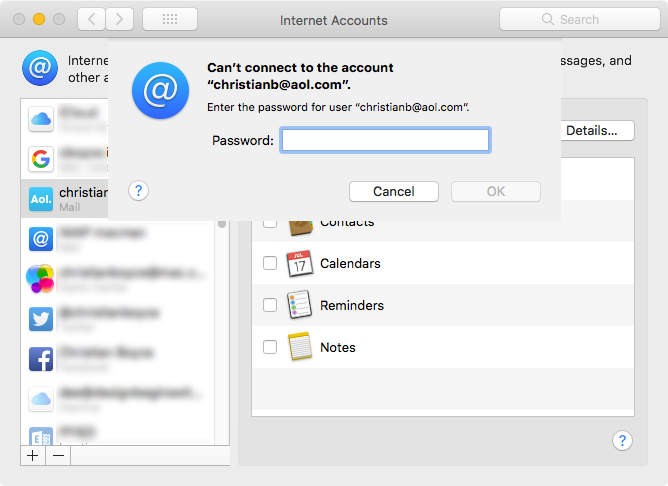
Let’s analyze what this means and what steps you need to take next.
For AOL Webmail Users
To begin with, there’s no effort required if you access your email on a Mac (or PC) by opening a web browser and typing “aol.com” to access your mail and compose new messages. All aspects of using AOL Mail will continue to function normally for you.
For Mac Mail App Users
To access your “actual” AOL account, you would go to www.aol.com in a browser and enter your AOL username and password. The Mail app is the only one that can use the app-only password.
Creating a password for an AOL app is simple, and the company even gives instructions. An overview:
- Sign in to your AOL account by visiting www.aol.com via a web browser.
- Click on your name in the top right to access your account settings.
- Select “Account Security” from the menu on the left.
- Next, select “Generate and manage app passwords” (look around, the link is small)
- Type in a name to use as a password. It is helpful to have a name like”Mail app for Mac”. When you’re ready, hit the “Generate” button to make the password.
It is recommended that you copy the password (or else write it down) and then use it to log into AOL on the device you are attempting to fix.
You have the option of starting over if you screw up. There is no need to panic. Keep in mind that AOL will not save app-specific passwords for later passwords. A new password can be created, but the previous ones’ cannot be retrieved.
Below is how the app-specific password will look:
jqxr wxpq mnix zwrt
A glaring point: the gaps aren’t actual spaces. They are not even worth considering. Nothing of them exists. Please create a password for the app that proves it to yourself. Just choose the password, copy it, and then use it (in Notes, an email, or in TextEdit– anywhere you can paste). You will see gaps between the words that shouldn’t be there. You should probably copy the app-specific password and paste it into the Internet Accounts settings window rather than writing it down and typing it in.
Preferences > Internet > Accounts > AOL Not Connecting
Another try is given if the password box does not appear immediately or if the app-specific password is entered and refused. To access the app-specific password, clear the top box, click your AOL account, and click the Details… button in the upper right. This solution should work for what we set out to do.
Those running Mojave (10.14) or Catalina (10.15) on their Macs no longer require the app-specific password when logging into the Mac Mail app. If you want to re-add the account, you’ll need to delete it first. To find out how simple that is, you can continue reading below.
To clarify, you will NOT lose any emails if you delete the account. Go to a service like aol.com and sign in to verify that your emails are either stored on the server or in your “On My Mac” folder (look for a folder on the left-hand side of the Mail app and see). Although the account will be deleted from your Mac, the email will still be stored on the server. Remember that you are simply deleting the account from your Mac, not the server’s mail. To put it simply, do what is outlined below. You are NOT deleting through your inbox and marking every single mail for deletion. Cancel the idea. In Settings, you select “Let Go” of Account. Moreover, we decided to include it once again.
Step 1: Click the Apple menu, then select System Preferences, Internet Accounts, your AOL account, and finally, the minus sign at the bottom left corner of that window. A message will appear asking if you want to disable the feature or delete it from all of your devices. To permanently remove something, select “Delete from all devices.”
Please look at the settings for your AOL account and note what is active and what isn’t before you delete it. For me, it’s strictly mail-only.
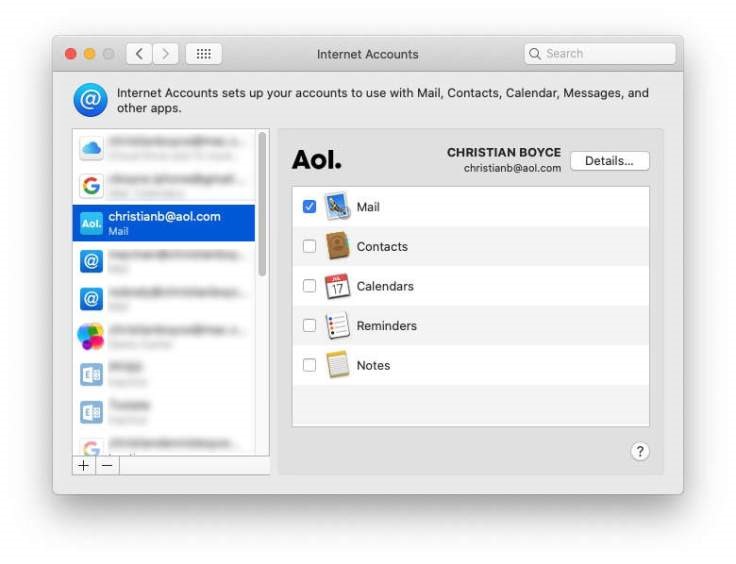
A new account addition is required at this time.
Step 2: To continue using AOL, go to Internet Accounts in System Preferences and click where it says “Aol.”: Enter your AOL username in the window that pops up. The “@aol.com” part is optional. Tick the box labeled “check me signed in.” Proceed with the next step by clicking.
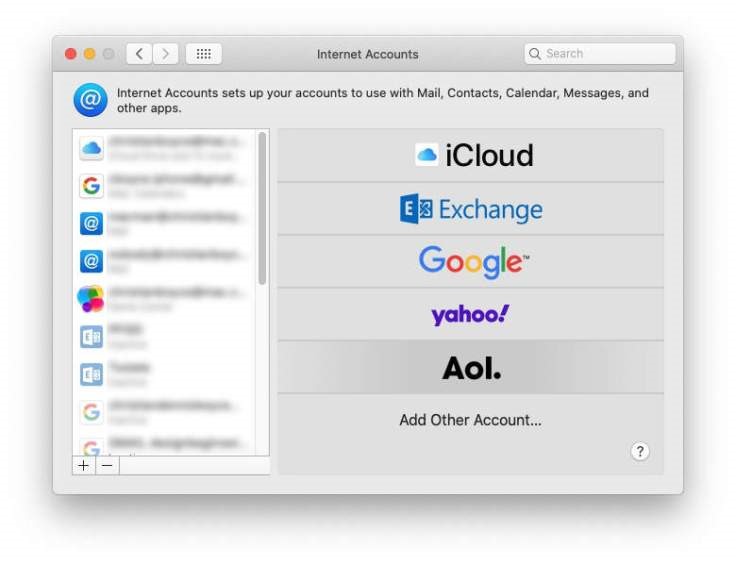
To remain logged in, please enter your username and check the checkbox.
Step 3: Log into AOL using your password. Select the sphere to make sure there is no misspelling. After that, proceed by selecting Next.
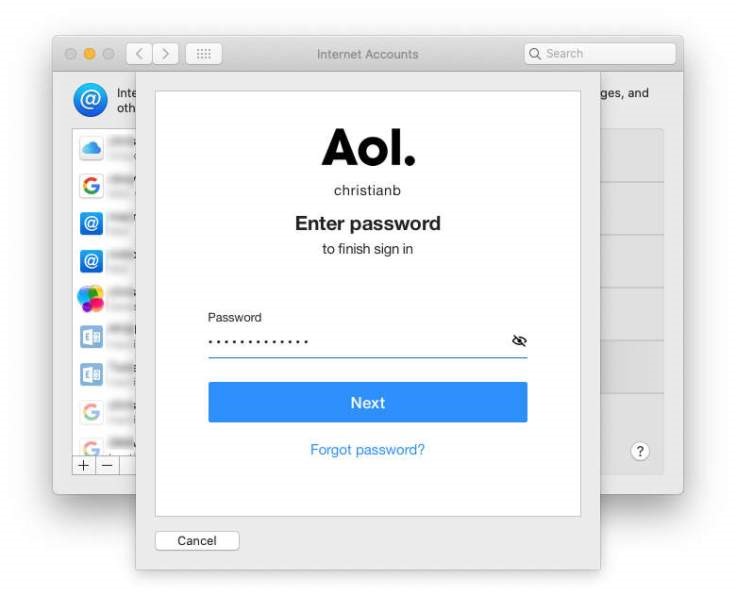
Step 4: You’ll see a message indicating that AOL has never seen you sign in from this device before. Instead, they suggest that you haven’t signed in from this device since you re-added the account two seconds ago, which is inaccurate. They will give you a code through email to proceed with the sign-in procedure. Choose between having AOL send you a text message or an email and then sit tight till the message arrives.
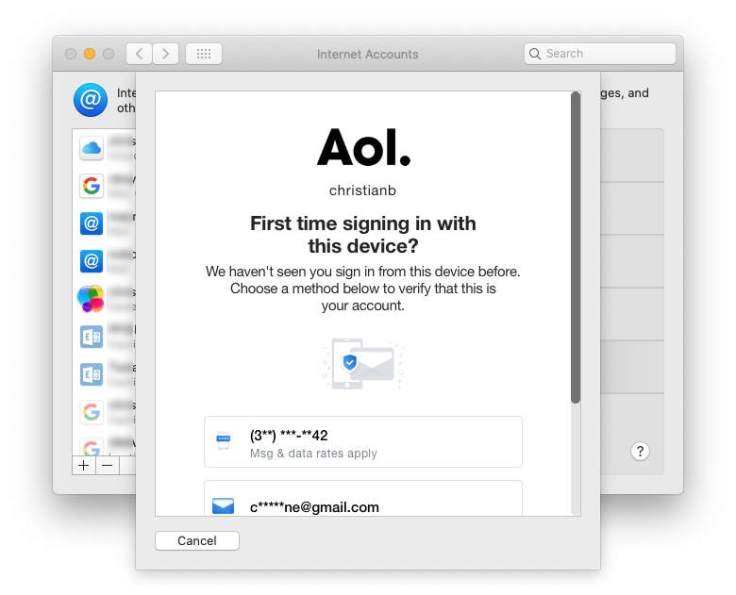
If you don’t want to check signing in and entering codes, choose “Don’t ask me again on this device” from the drop-down menu.
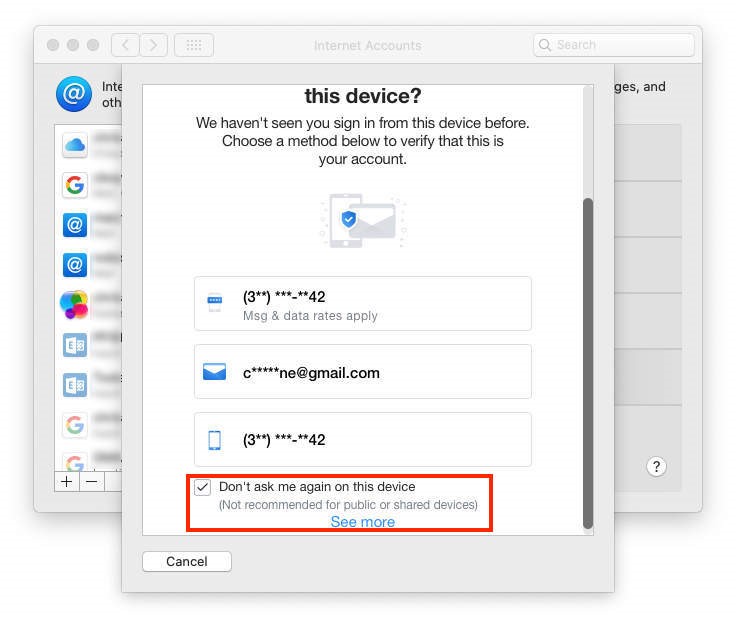
Step 5: Use the AOL code that was included in the message. (Don’t bother saving this code; AOL will send you a new one if you need a code again.) Then choose the Verify button. There is a time restriction on this, so hurry up.
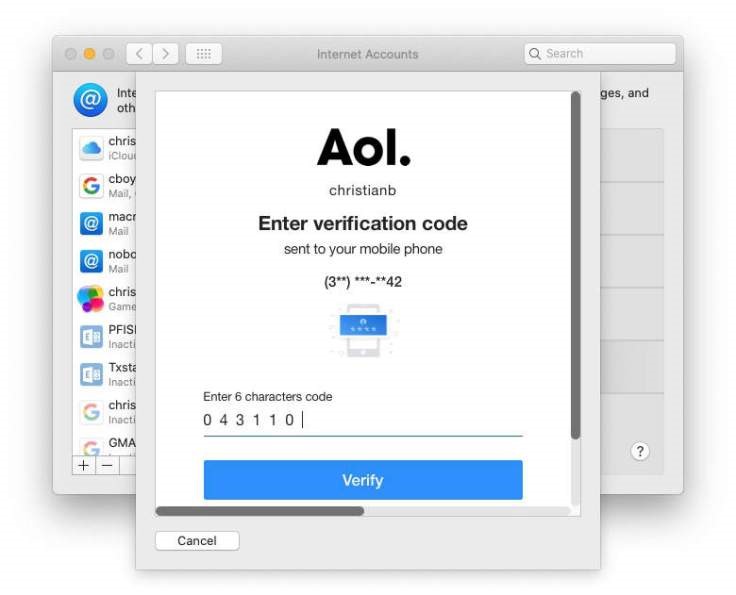
Inputting the AOL-sent iPad verification code
Step 6: The sixth step is to review the list of permissions you’re giving macOS and iOS. You may skip to the bottom and click Agree because this is all your personal information stored in your AOL Contacts, AOL Calendar, AOL mail, etc.
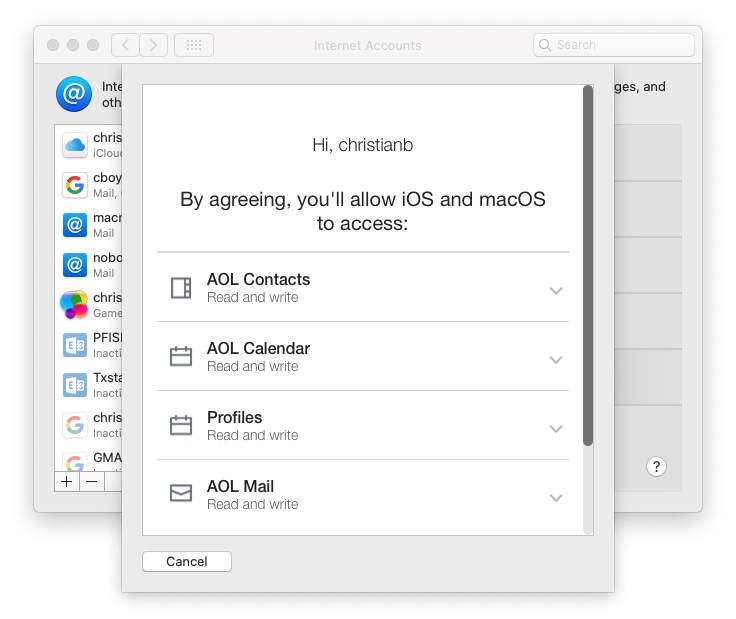
If you haven’t already noticed, the “Agree” button is buried at the very bottom of the window.
Step 7: Select the options for the services you aren’t currently using. I don’t want AOL to check everything, but that’s what it does by default (I only wish to Mail). To complete, select the Finish button.
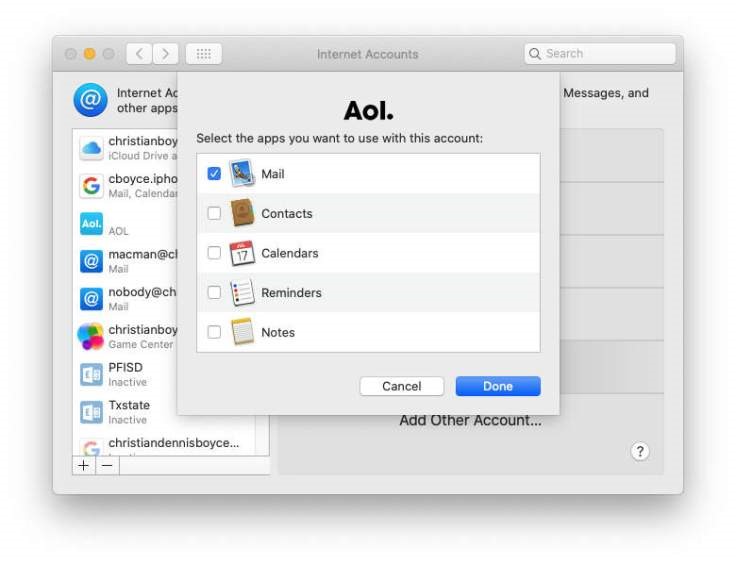
All set; I think that covers it.
For iPad Users
Perhaps logging in again will do the trick. If you have a relatively recent iPad, you may try this out:
- 1. Navigate to Passwords & Accounts in the iPad’s Settings menu.
- If you’re using iOS 14, update by selecting Settings, Mail, and Accounts.
- 2. In the second phase, log in to your AOL account.
- 3. A screen will appear with a large Aol logo at the top and the words “Sign in.” That’s excellent if your email address is already in our system. Otherwise, include it. The password field is not on this screen but on the one that follows, so make sure you select Next afterward.
A word of advice: if you can’t get to the login screen, try removing your account and adding it again. Make sure you choose “AOL” from the list of available account types (iCloud, Microsoft Exchange, Google, Yahoo!, AOL., and Outlook.com). Follow the steps below.
- 4. Click the “Sign in” button after putting in your password. If you’re having trouble logging into AOL on your iPad with your regular AOL password, you may create a new password for the app by following these steps.
- 5. The Agreement, at Last! Agree all of that is true. Choose “Agree” in the lower right corner.
Up top, you can perhaps find a Save button. You should tap it if you notice it.
Finding Alternative Solutions to AOL Mail Issues
Locating the source of the issue is a prerequisite to solving it. A possible explanation for why your preferences no longer function is if you changed them. Possibly the settings that used to work no longer do so because you utilize an AOL-managed Verizon.net email address.
Visit Apple’s Mail Settings Lookup website to learn the correct email settings. If you’re concerned about privacy, you can enter a fake email address. All you have to do is get the ending right. If your email address is “hot tamale@verizon.net,” you can access the settings for “anybody@verizon.net” and learn the relevant details, as seen below.
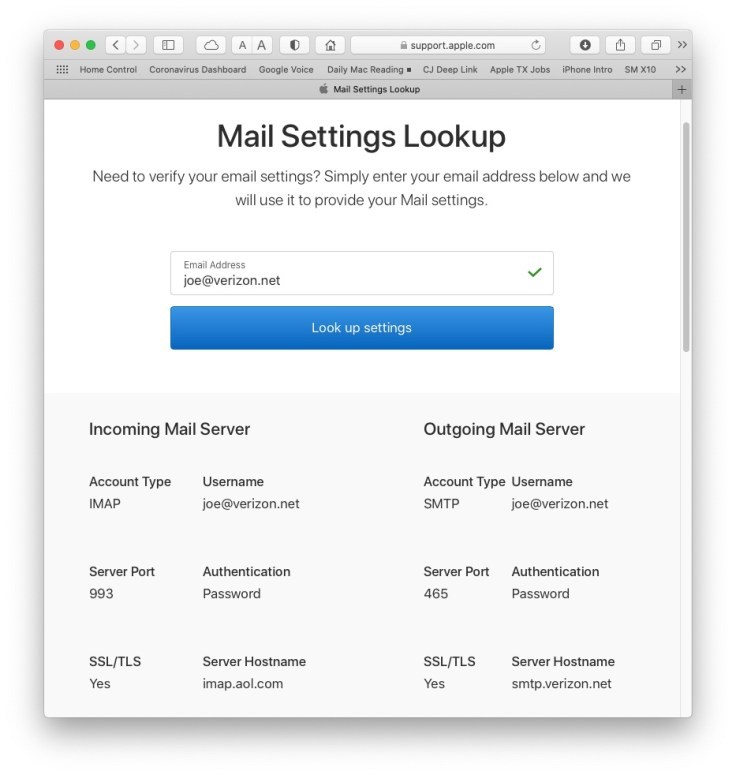
Checking an email address ending in “.verizon.net” returns results for configuring mail settings.
Take note that although map.aol.com handles incoming mail, smtp.verizon.net handles outgoing mail. You’d think they’d both be Verizon.net or AOL.com, but you’d be wrong. I assume (but I am not sure) that your email address would serve as your username.
I understand the confusion, especially when you compare it to the settings for a “genuine” AOL address:
It could not be your device if it’s not working correctly. Possible that the issue is on the end of AOL. Explore Downdetector.com to learn more.
Perhaps it wasn’t your computer or Internet connection that day if you couldn’t access your AOL mail. There were obviously problems with AOL.
Contact Software Warranty Inc
A trustworthy professional will start working on your issue within minutes of your contact to Software Warranty. They take great delight in always getting things done right on the dot. After only one phone call, they’ll do whatever it takes to get your AOL email back up and working on your iPad.
When fixing technical difficulties, Software Warranty will utilize only the safest and most advanced remote access methods to connect to your computer over the internet and fix it. After you provide our technical team permission to view your screen, we can remotely connect to your computer and assist you, regardless of whether you’re running Linux, Microsoft Windows, or macOS. All customer data is kept strictly secret, and customers can watch their technicians operate on their computers in real-time.
